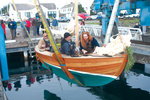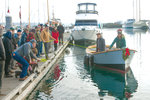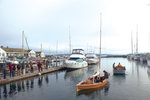The Northwest School of Wooden Boat Building had a rare double launch from Point Hudson on the afternoon on Dec. 9, as two separate building crews of students, alumni and instructors celebrated the …
This item is available in full to subscribers.
We have recently launched a new and improved website. To continue reading, you will need to either log into your subscriber account, or purchase a new subscription.
If you had an active account on our previous website, then you have an account here. Simply reset your password to regain access to your account.
If you did not have an account on our previous website, but are a current print subscriber, click here to set up your website account.
Otherwise, click here to view your options for subscribing.
* Having trouble? Call our circulation department at 360-385-2900, or email our support.
Please log in to continue |
|



The Northwest School of Wooden Boat Building had a rare double launch from Point Hudson on the afternoon on Dec. 9, as two separate building crews of students, alumni and instructors celebrated the completion and launch of two different vessels that Monday.
Sean Koomen, chief instructor for the school, also served as the lead for the initial part of the build for the first boat launched, the Paul Gartside-designed workboat “Orca,” whose actual name Koomen left up to whomever eventually buys it.
“The project was an ideal teaching tool, that was utilized by both our boat-building and marine systems programs,” said Koomen, who estimated that roughly 18 students and four instructors worked on the project over a two-year period. “The boat was ideal for the school, because it incorporated many details found on larger vessels, but in a compact yet sturdy little 18-footer.”
Gartside designed the boat in 2009, but Koomen couldn’t recall it ever having been built before.
Betsy Davis, executive director of the school, noted that the other instructors who contributed to the Gartside included boat-building specialist Jody Boyle — whose students finished the vessel’s interior, as he led the completion of that boat project — and lead systems instructor Kevin Ritz, whose students helped with systems in the Gartside.
Ginny Wilson, who graduated from the school in 2018, has worked on four completed boats so far, including the Gartside.
“Solving its construction problems was always challenging, but never boring,” Wilson said. “It’s super-rewarding to see a boat go into the water that you worked on.”
Wilson credited the completion of the Gartside to the degree of teamwork that she said the school instills in its students, “since if you want to get something like a boat done, you can’t do it alone,” but she also admitted that she deliberately sought out “the most complicated project” the school had to offer.
“If you do the hardest project, you’ll learn the most from it,” said Wilson, who’s spent the past few months in the employ of the Port Townsend Shipwrights Co-op, working “mostly “ on the Western Flier, John Steinbeck’s old boat, during that time.
The Gartside is currently for sale, and Koomen encouraged people to visit nwswb.edu/allboatsforsale to find out more.
The second boat launched had a much briefer build time, but a far richer history.
Leland Gibson, the boat-building instructor whose students constructed a Scandinavian sailing sjekte, led the completion of that project based on the design of a boat owned by Sean Rankins, who handled the rigging on the sjekte, and offered lots of technical support to the project.
Rankins, who owns Northwest Sails and Canvas, recalled how he and his wife, Inger, first acquired their now 80-year-old boat when they were living in her native Norway.
“It’s got that beautiful hourglass shape,” Rankins said. “The history of these boats is that they evolved from fishing into more recreational vessels, and were being used for racing by the time we acquired ours.”
Rankins and his wife extolled the virtues of a relatively smaller boat like the sailing sjekte, which requires fewer hands to operate and is more maneuverable through the tiny islands that are familiar to both Southern Norway and the Puget Sound.
“With the right wind and tide, you can go anywhere on one of these,” Rankins said. “We’ve taken our boat out to go camping for the day, with picnic lunches on the beach.”
Inger admitted that it took some time for her to appreciate why everyone was “so excited” about this particular boat design, since it was so ubiquitous to her upbringing in Norway.
“I didn’t realize it was a big deal,” Inger said. “I asked, ‘Aren’t all boats double-enders?’ But they’ve become less and less commonplace, especially as more people have gone with fiberglass boats.”
Rankins noted that his boat has been moored in the same slip at Point Hudson for the past 30 years, more than long enough for it to become Gibson’s favorite boat design, ever since he first saw it a decade ago.
Fortunately for Gibson, when the opportunity arose for him to lead fewer than half a dozen students in building a boat design of his choosing, a conversation with Rankins revealed that Rankins still had the plans, which was all that Gibson’s students needed to build their own recreation of that boat in nine months.
“It came out incredible,” Gibson said. “Every detail came together stunningly.”
One of the students was the man who would go on to own the boat, Bob Spychalski, a 35-year military veteran who served in both the U.S. Marine Corps and the U.S. Air Force, and whose first day of class at the school coincided with his first official day of retirement from the armed forces, in October of 2018.
“I never thought I’d be into sailing, but I’ve heard it’s awesome therapy, due to the quiet and calm of the waters,” said Spychalski, who named the vessel “Crysta Melanie” after his wife. “Plus, I love woodworking, and I appreciate how all these people took their time and put their heart and soul into this boat with me.”
Spychalski had no previous connection to or knowledge of the Northwest School of Wooden Boat Building before his daughter started sending away for college pamphlets, back when he was still stationed overseas, and they received one from the school by accident.
“She was like, ‘Hey, what’s this? I didn’t ask for this,’” Spychalski said. “And I was like, ‘Let me take a look.’”
Spychalski would follow up on the curiosity that the school’s pamphlet awakened in him, when he and his wife moved to the Seattle area to be close to where his daughter eventually chose to attend college.
Although Spychalski was only able to spend about six months working on the boat, before he went to supervise the house that’s being built for his family in Seabeck, he praised the other students as “a great crew.”